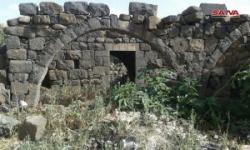INSTITUT SUPERIEUR D'ANTHROPOLOGIE
INSTITUTE OF ANTHROPOLOGY
ONLINE COURSES / COURS A DISTANCE
SUMMER TERM : JULY 2018
REGISTER NOW
SYRIE – 
 Al-Tha’la - Al-Tha’la village, to the west of Sweida city, is distinguished by its architectural style and archaeological landmarks which date back to the Nabataean, Roman, Byzantine and Arab Islamic eras.The remains of dilapidated houses, arches and parts of stone doors decorated with cornices, arches, columns, crowns and writings are still stand until now throughout the village in addition to three round pools carved in stones. The village has an important strategic location since it links Jabal al-Arab (Al-Arab Mountain) with Sahel Horan (the plain of Horan), Head of Sweida Antiquities Department Nashaat Kiwan said. He added that a collection of ancient Greek inscriptions indicate to an ancient urban and human settlement in the village was discovered. Kiwan said that the old town in the village is characterized by its basalt architecture dating back to ancient times, most of them from the classical Roman and Byzantine eras.
Al-Tha’la - Al-Tha’la village, to the west of Sweida city, is distinguished by its architectural style and archaeological landmarks which date back to the Nabataean, Roman, Byzantine and Arab Islamic eras.The remains of dilapidated houses, arches and parts of stone doors decorated with cornices, arches, columns, crowns and writings are still stand until now throughout the village in addition to three round pools carved in stones. The village has an important strategic location since it links Jabal al-Arab (Al-Arab Mountain) with Sahel Horan (the plain of Horan), Head of Sweida Antiquities Department Nashaat Kiwan said. He added that a collection of ancient Greek inscriptions indicate to an ancient urban and human settlement in the village was discovered. Kiwan said that the old town in the village is characterized by its basalt architecture dating back to ancient times, most of them from the classical Roman and Byzantine eras.
https://sana.sy/en/?p=138844
EGYPTE - Oxyrhynchus - In 1896, two young archaeologists, Bernard Pyne Grenfell and Arthur Surridge Hunt, began excavating an ancient garbage dump at Oxyrhynchus (modern Al-Bahnasa) in Egypt. They were looking for ancient papyri. Their work led to some of the most significant finds in archaeological history, such as thousands of fragments of texts, including some of the oldest fragments of the New Testament and other early Christian writings. Recently, the Egyptian Exploration Society announced the discovery of a late second- or early third-century CE fragment of the first chapter of the Gospel of Mark, recently published in The Oxyrhynchus Papryi Volume 83 (2018).
https://sputniknews.com/viral/201805261064846111-ancient-bible-found-egyptian-dump/
IRAN –  Darian - Explorations and studies carried out during the salvage explorations program in the area of Darian Dam. The results of their research on the works and remains of different archaeological periods ranging from the Paleolithic, village-dwelling, the Iron Age to the recent centuries. The areas inspected included a place (graveyard) dating back to the Parthian era and the site of Neyabad dam and later an Iron Age grave in the vicinity of Ravar Village which was explored during the salvage explorations in the area of Darian dam.The large grave with rocky stone architecture without any mortar dates back to the first millennium BC which, after completion of the explorations and with the support of the Iran Water Resources Development Company and the Cultural Heritage Department of Kurdistan Province and the village administration of Ravar Village turned into a site museum.
Darian - Explorations and studies carried out during the salvage explorations program in the area of Darian Dam. The results of their research on the works and remains of different archaeological periods ranging from the Paleolithic, village-dwelling, the Iron Age to the recent centuries. The areas inspected included a place (graveyard) dating back to the Parthian era and the site of Neyabad dam and later an Iron Age grave in the vicinity of Ravar Village which was explored during the salvage explorations in the area of Darian dam.The large grave with rocky stone architecture without any mortar dates back to the first millennium BC which, after completion of the explorations and with the support of the Iran Water Resources Development Company and the Cultural Heritage Department of Kurdistan Province and the village administration of Ravar Village turned into a site museum.
http://www.irna.ir/en/News/82927670